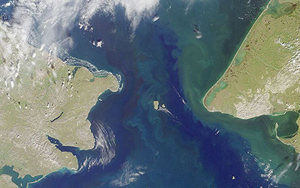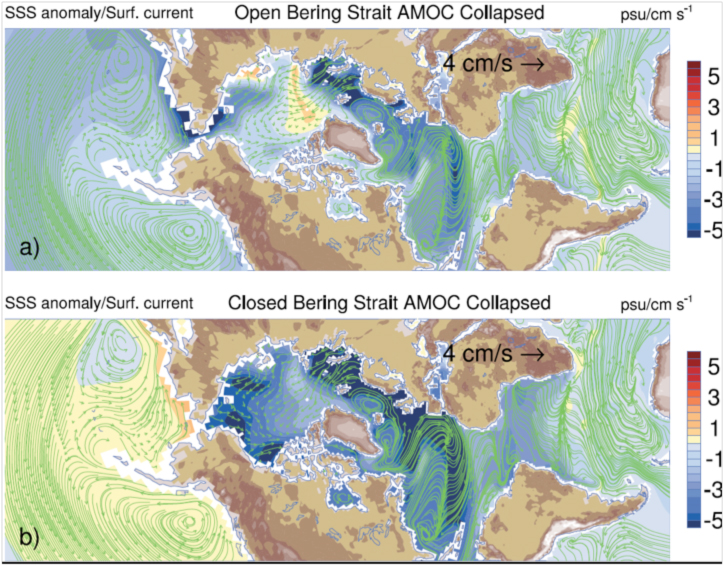The Bering Strait comes of age
A series of papers sheds light on the strait’s importance to global climate
May 21, 2012 - by Staff
May 21, 2012 - by Staff
May 22, 2012 • For such a small passage—a mere 53 miles (85 kilometers) of seawater between Russia and Alaska—the Bering Strait has had an outsized influence on Earth’s climate over the past 100,000 years. NCAR scientist Aixue Hu has been slowly unraveling the story of the tiny strait and its global reach. With the publication of his third related paper in the past few years, a narrative is emerging that illustrates the complexity of our planet’s climate system.

Aixue Hu. (©UCAR. Photo by Carlye Calvin. This image is freely available for media and nonprofit use.)
Hu, a meteorologist and physical oceanographer by training, first became interested in the Bering Strait in the early 2000s when he was running modeling experiments on the Atlantic meridional overturning circulation (AMOC). Part of a powerful global conveyor belt, the AMOC brings warm, tropical water north in the Atlantic Ocean and carries cold, dense water south. Hu noticed that the circulation responded differently in his experiments depending upon whether the Bering Strait was open, as it is now, or closed due to lower sea levels, with a land bridge in its place.
Intrigued, Hu delved deeper into the subject, and realized that the Bering Strait may contain the answer to a key mystery of the last glacial period: Why, starting about 116,000 years ago, did northern ice sheets repeatedly advance and retreat for about the next 70,000 years? The enormous ice sheets held so much water that sea levels rose and dropped by as much as about 100 feet (30 meters) during these intervals.
In a 2010 paper in Nature Geoscience, "Influence of Bering Strait flow and North Atlantic circulation on glacial sea-level changes," Hu and colleagues proposed that water levels in the Bering Strait may have helped drive global climate patterns as repeated opening and closing of the strait due to fluctuating sea levels affected the AMOC.
“The global climate is sensitive to impacts that may seem minor,” Hu says. “Even small processes, if they are in the right location, can amplify changes in climate around the world.”
That particular process went like this:
The research, which NCAR summarized in a news release, was just the beginning. In "The Pacific-Atlantic seesaw and the Bering Strait," published earlier this year in Geophysical Research Letters, Hu turned his attention to how the strait may have affected a seesaw-like climate pattern between the Atlantic and Pacific oceans that occurred during glacial times. During a particular episode, when sea levels were lower than today and the Bering Strait was closed, the North Pacific warmed while the North Atlantic cooled.

The 53-mile passage between Russia (left) and Alaska (right) plays an outsized role in global climate, according to a series of recent analyses. (Wikimedia image from NASA Multi-angle Imaging Spectroradiometer.)
Hu’s research team ran two simulations, one with the Bering Strait open and one closed. They confirmed that the Pacific-Atlantic climate pattern could only have happened when the Bering Strait closed and communication between the two oceans was cut off. The AMOC would have collapsed as a result, cooling the North Atlantic and warming the North Pacific.
A collapse of the AMOC—in which warm, salty water stops flowing north—has been suggested as a possible mechanism for explaining abrupt climate changes during the glacial period and even provided supposed scientific justification for the instant ice age that descends in The Day After Tomorrow, the 2004 blockbuster film.
For the next step, Hu decided to test the stability of the AMOC, with an eye toward determining if abrupt climate transitions could occur in the future as climate warms and the vast Greenland Ice Sheet melts. (With global sea levels expected to rise as our planet warms, the Bering Strait is unlikely to close in the foreseeable future.)
Using fully coupled climate models, the scientists again ran two sets of simulations, one with the Bering Strait open and the other with it shut. They gradually injected large amounts of fresh water to the North Atlantic—simulating meltwater from ice sheets during the occasional warm spells that punctuated the last ice age—to see if they could trigger a shutdown of the AMOC.
The results? A paper in Proceedings of the National Academy of Sciences, "The role of the Bering Strait on the hysteresis of the ocean conveyor belt circulation and glacial climate stability," reports that in both simulations, surface waters became so fresh that they did not sink beneath the underlying salt water. This in turn shut down the AMOC and put the North Atlantic into a cold spell. However, the two simulations showed an important difference. When the Bering Strait was closed, it took up to 1,400 years for the AMOC to recover; with the strait open, it rarely took more than 400.
This makes the scenario in The Day After Tomorrow highly improbable, according to Hu. “Ocean circulation is stable when the Bering Strait is open, meaning that a sudden collapse of the AMOC due to freshwater runoff—such as from the Greenland ice sheet—is not likely to occur with an open strait,” he says. “However, the AMOC could slow down in response to warming and increased runoff from Greenland.”
The Intergovernmental Panel on Climate Change (IPCC) made the same prediction in 2007 based on its climate models, stating that it is very likely that the AMOC will slow during the 21st century, but very unlikely that it will undergo an abrupt transition. Hu’s research is significant in that it exposes the underlying physical mechanism behind the model predictions.
The next step for Hu and his team will be to further explore the stability of the AMOC’s active and inactive states and to study the conditions that would lead to an abrupt collapse of the AMOC with a closed Bering Strait under glacial conditions. They’ll also look at how a closure of the strait can significantly affect how oceanic circulation responds to external freshwater forcing, with broad ramifications for atmospheric circulation.

These maps show the results of computer simulations of sea surface salinity and sea surface currents for the Bering Strait when it is open (top) and closed (bottom). In both cases, the Atlantic meridional overturning circulation has been turned "off" in the model. The shading shows sea surface salinity relative to salinity when the AMOC is active, while the arrows represent sea surface currents. When the Bering Strait is open, fresh water flows from the Arctic Ocean into the Pacific, leading to a freshening of the North Pacific. When the strait is closed, it prevents fresh water transport into the Pacific, leading to a much fresher Arctic, but a saltier North Pacific. (Image courtesy Aixue Hu.)